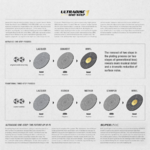I think the basic idea is that to do what MoFi purports to do with one-steps, working from the master tape, they'd have to go back to that tape each time they want to press another 1,000 records, because they'd need a new lacquer to create a new 'convert' (in their terms). Since going back to the tape 40 times (for Thriller's 40,000 run) is arguably impossible, there has to be another way, which we now have reason to believe is creating a DSD file from the master tape, and working from that DSD file each time a new lacquer is needed.
So it's not that the convert is digital, it's that there is a step being added between the master tape and the lacquer, and that step is digital.
Master Tape ---> DSD copy ---> Lacquer ---> Convert ---> Vinyl
In this way, the master tape is preserved after its initial (single) use, and each lacquer should be identical, with no "generational loss" in the process of creating as many of them as desired.



